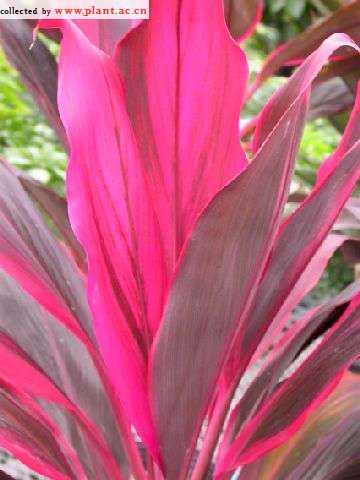Cordyline fruiticosaTi plant
科:龙舌兰科
Family:Agavaceae
属:朱蕉属
common name:Ti plant
introduce:Plant Type: Broadleaf evergreen
Family: Agavaceae
Missouri Native: No
Native Range: Southeast Asia, Australia, Pacific Islands
Height: 9 to 15 feet
Spread: 3 to 8 feet
Bloom Time: Seasonal bloomer
Bloom Color: White to pale lavender
Sun: Part shade to full shade
Water: Medium moisture
Maintenance: Medium
General Culture:
Grow in St. Louis as a houseplant. Best in a well-drained, peaty potting mixture. Plants need bright indirect light, but tolerate light shade. Avoid direct sun. Needs consistently moist soils from spring to fall. Does not require winter dormancy, but appreciates a resting period with reduced watering from fall to late winter. Ti plant can be relatively easy to grow indoors as long as its high humidity needs can be met. Consider growing in humidified rooms, place pot on a bed of wet pebbles or grow in bathrooms. Regular temperatures in summer and minimum 65F in winter. Plants may be grown from stem sections, commercially referred to as Ti logs, by placing the same on a bed of moist gravel until roots appear.
Noteworthy Characteristics:
Ti plant typically grows as a short tree or shrub to 10?tall in its native habitat of tropical Southeast Asia, eastern Australia and some Pacific islands including Hawaii. In the United States, it can only be grown outdoors in far southern Florida, southwestern United States and Hawaii. As a houseplant in the St. Louis area, it more often grows a 3-6?tall. This is a long-lived broadleaf evergreen that features thin lance shaped leaves (to 30?long and 6?wide) that emerge pinkish red, but mature to deep green. Scented, white to pale lavender flowers appear in panicles (to 12?long) in summer and are followed by red berries. Houseplants rarely flower and fruit, however. As the plant ages, it loses its lower leaves. Leaves of this plant have been used in Hawaii to make hula skirts and edible rhizomes for food. Varieties in commerce include plants with colored or variegated foliage. Synonymous with C. terminalis.
Problems:
No serious insect or disease problems. Watch for aphids, scale, spider mites and mealybugs.
Uses:
Houseplant for bright, humid areas.
